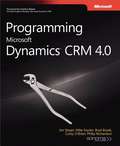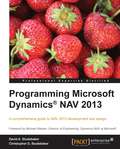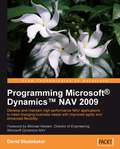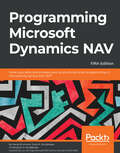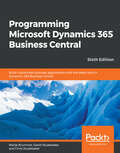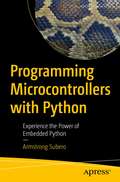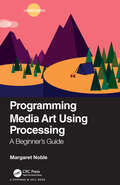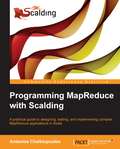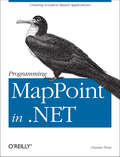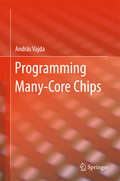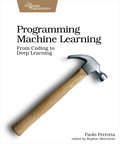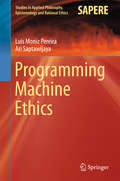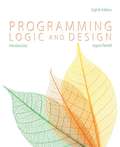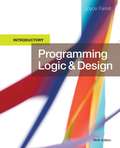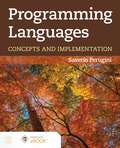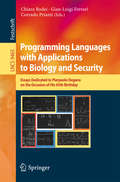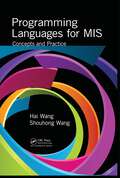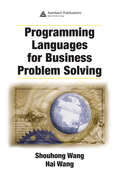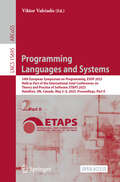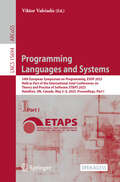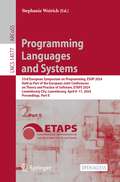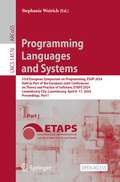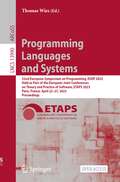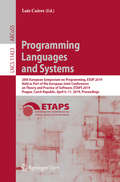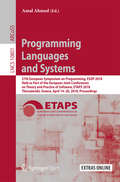- Table View
- List View
Programming Microsoft Dynamics® CRM 4.0
by Mike Snyder Jim Steger Brad Bosak Corey O'Brien Phil RichardsonGet answers to common questions about setting up the design environment and building custom solutions with Microsoft Dynamics CRM. Delve into core architecture, tools, and techniques, and learn how to exploit powerful customization features. Authored by industry-leading experts, this book shows how to deliver intelligent CRM solutions that meet the unique challenges and requirements of your business. Discover how to: Set up the development environment Enhance the product's APIs with your own code Execute business logic using plug-ins Build custom workflows that extend native workflow functions Create user-friendly integration with scripts and application extensions Code custom pages optimized for Microsoft Outlook with Offline Access Extend Microsoft Dynamics CRM using ASP.NET Create advanced Windows Workflow Foundation solutions Extend multilingual and multicurrency features Construct a custom security-access solution Get code samples on the Web.
Programming Microsoft Dynamics NAV 2013
by Christopher D. Studebaker David A. StudebakerWritten as a practical guide, this book will show you how to utilize Dynamics NAV 2013 to its full potential. Designed to be a comprehensive reference, it should be the perfect companion for any NAV developer, manager or consultant. This book is for experienced programmers who are either new to Microsoft Dynamics NAV or for experienced developers that want to utilize the fantastic new features of NAV 2013. Managers and consultants will also benefit from understanding NAV environments in order to build on their skills and experience during development projects.
Programming Microsoft Dynamics NAV 2009
by David StudebakerThis book takes you through the important topics of Microsoft Dynamics NAV with clear explanations and practical example code. There is also a substantial amount of reference material, which has been brought together in one place for you. This book takes care of what the working developer needs to know in order to become productive as quickly as possible. This book is for NAV consultants and developers, and developers or designers of business applications. Managers of NAV development or consultants will also find the book a helpful introduction to understanding NAV development capabilities. Any previous experience with NAV is not expected. Some basic knowledge of object-oriented programming will be quite helpful.
Programming Microsoft Dynamics NAV - Fifth Edition: Hone your skills and increase your productivity when programming in Microsoft Dynamics NAV 2017, 5th Edition
by Mark Brummel Christopher D. Studebaker David A. StudebakerCustomize your NAV applications About This Book • Gain from the insights and methods of industry-leading experts and tailor your applications to best suit the needs of your business • Learn through the detailed explanations and useful examples that are presented in a logical, step-by-step manner • This comprehensive guide is written with the goals of being used as a classroom text, a self-study text, and as a handy in-depth reference guide Who This Book Is For This book will appeal to all those who want to learn about NAV's powerful and extensive built-in development capabilities. It assumes that you understand programming and are familiar with business application software, although you aren't expected to have worked with NAV before. ERP consultants and managers of NAV development will also find the book helpful. What You Will Learn • Productively and effectively use the development tools that are built into Dynamics NAV • Understand the strengths of NAV's development tools and how they can be applied to address functional business requirements • Introduction to programming using the C/AL language in the C/SIDE Development Environment • Explore functional design and development using C/AL • Leverage advanced NAV development features and tools • Get to know the best practices to design and develop modifications of new functionality integrated with the standard NAV software In Detail Microsoft Dynamics NAV is a full business solution suite, and a complete ERP solution, which contains a robust set of development tools to support customization and enhancement. These tools help in greater control over financials and can simplify supply chain, manufacturing, and operations. This book will take you from an introduction to Dynamics NAV and its integrated development tools to being a productive developer in the Dynamics NAV Development Environment. You will find this book very useful if you want to evaluate the product's development capabilities or need to manage Dynamics NAV based projects. It will teach you about the NAV application structure, the C/SIDE development environment, the C/AL language paired with the improved editor, the construction and uses of each object type, and how it all fits together to build universal applications. With this new edition, you will be able to understand how to design and develop using Patterns and new features such as Extensions and Events. Style and approach This book is filled with examples and will serve as a comprehensive reference guide, complementing NAV's Help files.
Programming Microsoft Dynamics 365 Business Central: Build customized business applications with the latest tools in Dynamics 365 Business Central, 6th Edition
by David Studebaker Mark Brummel Chris StudebakerExplore the fundamentals of Dynamics 365 Business Central and the Visual Studio Code development environment with the help of useful examples and case studiesKey FeaturesTailor your applications to best suit the needs of your businessExplore the latest features of Business Central with examples curated by industry expertsIntegrate Business Central features in your applications with this comprehensive guideBook DescriptionMicrosoft Dynamics 365 Business Central is a full ERP business solution suite with a robust set of development tools to support customization and enhancement. These tools can be used to tailor Business Central's in-built applications to support complete management functions for finance, supply chain, manufacturing, and operations.Using a case study approach, this book will introduce you to Dynamics 365 Business Central and Visual Studio Code development tools to help you become a productive Business Central developer. You'll also learn how to evaluate a product's development capabilities and manage Business Central-based development and implementation. You'll explore application structure, the construction of and uses for each object type, and how it all fits together to build apps that meet special business requirements.By the end of this book, you'll understand how to design and develop high-quality software using the Visual Studio Code development environment, the AL language paired with the improved editor, patterns, and features.What you will learnProgramming using the AL language in the Visual Studio Code development environmentExplore functional design and development using ALHow to build interactive pages and learn how to extract data for usersHow to use best practices to design and develop modifications for new functionality integrated with the standard Business Central softwareBecome familiar with deploying the broad range of components available in a Business Central systemCreate robust, viable systems to address specific business requirementsWho this book is forIf you want to learn about Dynamics 365 Business Central's powerful and extensive built-in development capabilities, this is the book for you. ERP consultants and managers of Business Central development will also find this book helpful. Although you aren't expected to have worked with Dynamics Business Central, basic understanding of programming and familiarity with business application software will help you understand the concepts covered in this book.
Programming Microcontrollers with Python: Experience the Power of Embedded Python
by Armstrong SuberoFor the first time microcontrollers are powerful enough to be programmed in Python. The landscape of embedded systems development is changing, microcontrollers are becoming more powerful, and the rise of the internet of things is leading more developers to get into hardware. This book provides the solid foundation to start your journey of embedded systems development and microcontroller programming with Python. You’ll quickly realize the value of using Python. The theme of the book is simplicity and the cleanness and elegance of Python makes that possible. Featuring a step-by-step approach, this single source guide balances complexity and clarity with insightful explanations that you’ll easily grasp. Python is quickly becoming the language of choice for applications such as machine learning and computer vision on embedded devices. What would previously be daunting and exceedingly difficult to do in C or C++ is now possible with Python because of its level of abstraction. Programming Microcontrollers with Python is your path to bringing your existing skills to the embedded space. What You’ll Learn Review microcontroller basics and the hardware and software requirements Understand an embedded system’s general architectureFollow the steps needed to carry a product to market Take a crash course in Python programming Program a microcontrollerInterface with a microcontroller using LCD and Circuit PythonUse and control sensors Who This Book Is For Those getting started with microcontrollers, those new to C, C++, and Arduino programming, web developers looking to get into IoT, or Python programmers who wish to control hardware devices.
Programming Media Art Using Processing: A Beginner's Guide
by Margaret NobleProgramming Media Art Using Processing: A Beginner's Guide provides an entry-level exploration into visual design through computer programming using the open source and artist-friendly language, Processing. Used by hundreds of students, this learning system breaks lessons down into strategic steps towards fun and creative media art projects. This book provides a linear series of lessons with step-by-step examples that lead to beginning media art projects, including abstract designs, pixel landscapes, rollover animations, and simple video games. Computer programming can be overwhelming for the first-time learner, but this book makes the learning of code more digestible and fun through a full color, well-diagrammed, and deeply explained text presentation. Lessons are rhythmically broken down into digestible parts with code annotations and illustrations that help learners focus on the details one step at a time. The content is legible, flexible, and fun to work with because of its project-based nature. By following the lessons and producing the projects sequentially in this book, readers will develop the beginning foundational skills needed to understand computer programming basics across many languages and also explore the art of graphic design. Ultimately, this is a hands-on, practical guide.
Programming MapReduce with Scalding
by Antonios ChalkiopoulosThis book is an easy-to-understand, practical guide to designing, testing, and implementing complex MapReduce applications in Scala using the Scalding framework. It is packed with examples featuring log-processing, ad-targeting, and machine learning. This book is for developers who are willing to discover how to effectively develop MapReduce applications. Prior knowledge of Hadoop or Scala is not required; however, investing some time on those topics would certainly be beneficial.
Programming MapPoint in .NET
by Chandu ThotaInteractive web maps generated by MapPoint-Microsoft's popular mapping technology are crucial for businesses in a number of fields, including real estate, package delivery, and commercial air travel. In a word, MapPoint provides businesses with "location." Specifically, it provides an integrated set of products, servers, and services to enable a business to track the precise location of remote assets, thereby reducing operational costs and improving productivity. Whether the asset is a truck, a taxi, or even a field rep, MapPoint can tell you exactly where it is at any time. Programming MapPoint in .NET from O'Reilly shows you how to use MapPoint to build custom applications for the desktop, the web, and mobile devices. The book also explains how to analyze and share data generated from a wide range of maps, including those that show demographic trends, population density, and sales potential. Chandu Thota, one of Microsoft's main MapPoint developers and the book's author, has organized the material into four major sections, each dedicated to a different MapPoint technology: MapPoint 2004 - calculating routes, rendering data maps, integrating with Global Positioning System (GPS) for obtaining real-time location MapPoint Web Service - techniques for finding points of interest, creating applications using the Find APIs and Route APIs, rendering LineDrive maps and polygonsMapPoint Location Server - deployment scenarios, getting real-time location using mobile phones, managing contacts and privacy settings MSN Virtual Earth - the basics of programming with new MSN Virtual Earth APIs The book provides a jumpstart for working with these technologies, including in-depth discussions about the core concepts and sample code provided in C#. It's ideal for anyone who wants to develop locations-based applications with MapPoint technologies. The next time you follow online directions to the airport, you can chalk up an assist to MapPoint's state-of-the-art interactive mapping abilities. Better yet, you'll know how to create that same type of map yourself.
Programming Many-Core Chips
by András VajdaThis book presents new concepts, techniques and promising programming models for designing software for chips with "many" (hundreds to thousands) processor cores. Given the scale of parallelism inherent to these chips, software designers face new challenges in terms of operating systems, middleware and applications. This will serve as an invaluable, single-source reference to the state-of-the-art in programming many-core chips. Coverage includes many-core architectures, operating systems, middleware, and programming models.
Programming Machine Learning: From Coding to Deep Learning
by Paolo PerrottaYou've decided to tackle machine learning - because you're job hunting, embarking on a new project, or just think self-driving cars are cool. But where to start? It's easy to be intimidated, even as a software developer. The good news is that it doesn't have to be that hard. Master machine learning by writing code one line at a time, from simple learning programs all the way to a true deep learning system. Tackle the hard topics by breaking them down so they're easier to understand, and build your confidence by getting your hands dirty. Peel away the obscurities of machine learning, starting from scratch and going all the way to deep learning. Machine learning can be intimidating, with its reliance on math and algorithms that most programmers don't encounter in their regular work. Take a hands-on approach, writing the Python code yourself, without any libraries to obscure what's really going on. Iterate on your design, and add layers of complexity as you go. Build an image recognition application from scratch with supervised learning. Predict the future with linear regression. Dive into gradient descent, a fundamental algorithm that drives most of machine learning. Create perceptrons to classify data. Build neural networks to tackle more complex and sophisticated data sets. Train and refine those networks with backpropagation and batching. Layer the neural networks, eliminate overfitting, and add convolution to transform your neural network into a true deep learning system. Start from the beginning and code your way to machine learning mastery. What You Need: The examples in this book are written in Python, but don't worry if you don't know this language: you'll pick up all the Python you need very quickly. Apart from that, you'll only need your computer, and your code-adept brain.
Programming Machine Ethics
by Luís Moniz Pereira Ari SaptawijayaThis book addresses the fundamentals of machineethics. It discusses abilities required for ethical machine reasoning and theprogramming features that enable them. It connects ethics, psychologicalethical processes, and machine implemented procedures. From a technical pointof view, the book uses logic programming and evolutionary game theory to modeland link the individual and collective moral realms. It also reports on theresults of experiments performed using several model implementations. Opening specific and promising inroads into the terra incognita of machine ethics, theauthors define here new tools and describe a variety of program-tested moralapplications and implemented systems. In addition, they provide alternativereadings paths, allowing readers to best focus on their specific interests andto explore the concepts at different levels of detail. Mainly written for researchers in cognitivescience, artificial intelligence, robotics, philosophy of technology andengineering of ethics, the book willalso be of general interest to otheracademics, undergraduates in search of research topics, science journalists aswell as science and society forums, legislators and military organizationsconcerned with machine ethics.
Programming Logic And Design: Introductory
by Joyce FarrellThis fully revised eighth edition of Joyce Farrell’s PROGRAMMING LOGIC AND DESIGN: INTRODUCTORY prepares student programmers for success by teaching them the fundamental principles of developing structured program logic. Widely used in foundational Programming courses, this popular text takes a unique, language-independent approach to programming, with a distinctive emphasis on modern conventions. Noted for its clear, concise writing style, the book eliminates highly technical jargon while introducing universal programming concepts and encouraging a strong programming style and logical thinking. Quick Reference boxes, a feature new to this edition, provide concise explanations of important programming concepts. Each chapter now also contains a Maintenance Exercise, in which the student is presented with working logic that can be improved. In addition to each chapter’s text-based Debugging Exercises, this edition now includes Flowchart Debugging Exercises as well.
Programming Logic And Design, Introductory
by Joyce FarrellPrepare for programming success by learning the fundamental principles of developing structured program logic with Farrell’s PROGRAMMING LOGIC AND DESIGN: INTRODUCTORY, 9E. Widely used in foundational programming courses, this popular book takes a unique, language-independent approach to programming with a distinctive emphasis on modern conventions. <P><P> Noted for its clear, concise writing style, the book eliminates highly technical jargon while introducing universal programming concepts and encouraging a strong programming style and logical thinking. Frequent side notes and Quick Reference boxes provide concise explanations of important programming concepts. Each chapter also begins with a list of objectives and provides a concise summary and a list of key terms. End-of-chapter practice offers multiple-choice review questions, programming and gaming exercises, debugging exercises, and a maintenance exercise that challenges you to improve the working logic presented.
Programming Languages: Concepts and Implementation
by Saverio PeruginiProgramming Languages: Concepts and Implementation teaches language concepts from two complementary perspectives: implementation and paradigms. It covers the implementation of concepts through the incremental construction of a progressive series of interpreters in Python, and Racket Scheme, for purposes of its combined simplicity and power, and assessing the differences in the resulting languages.
Programming Languages with Applications to Biology and Security
by Chiara Bodei Gian-Luigi Ferrari Corrado PriamiThis Festschrift volume is published in honor of Pierpaolo Degano on the occasion of his 65th birthday and is the outcome of a colloquium held in Pisa, Italy, in June 2015. Pierpaolo Degano has worked on a large variety of topics including formal program semantics, concurrency theory, systems biology and security. The volume contains 22 refereed papers and one extended abstract, including personal memoirs and regular research papers by close collaborators and friends and a laudatio illustrating his distinguished career and his main scientific contributions. The papers deal with the main research topics explored by Pierpaolo Degano and those still under his investigation.
Programming Languages for MIS: Concepts and Practice
by Shouhong Wang Hai WangProgramming Languages for MIS: Concepts and Practice supplies a synopsis of the major computer programming languages, including C++, HTML, JavaScript, CSS, VB.NET, C#.NET, ASP.NET, PHP (with MySQL), XML (with XSLT, DTD, and XML Schema), and SQL. Ideal for undergraduate students in IS and IT programs, this textbook and its previous versions have bee
Programming Languages for Business Problem Solving
by Shouhong Wang Hai WangIt has become crucial for managers to be computer literate in today's business environment. It is also important that those entering the field acquire the fundamental theories of information systems, the essential practical skills in computer applications, and the desire for life-long learning in information technology.Programming Languages
Programming Languages and Systems: 34th European Symposium on Programming, ESOP 2025, Held as Part of the International Joint Conferences on Theory and Practice of Software, ETAPS 2025, Hamilton, ON, Canada, May 3–8, 2025, Proceedings, Part II (Lecture Notes in Computer Science #15695)
by Viktor VafeiadisThe open access book set LNCS 15694 + LNCS 15695 constitutes the proceedings of the 34th European Symposium on Programming, ESOP 2025, which was held as part of the International Joint Conferences on Theory and Practice of Software, ETAPS 2025, in Hamilton, Canada, during May 3-8, 2025. The 30 full papers included in the proceedings were carefully reviewed and selected from a total of 88 submissions. The proceedings also contain two short artifact reports. The papers focus on aspects of programming language research such as programming paradigns and styles; methods and tools to specify and reason about programs and languages; programming language foundations; methods and tools for implementation, concurrency and districution; and applications and emerging topics.
Programming Languages and Systems: 34th European Symposium on Programming, ESOP 2025, Held as Part of the International Joint Conferences on Theory and Practice of Software, ETAPS 2025, Hamilton, ON, Canada, May 3–8, 2025, Proceedings, Part I (Lecture Notes in Computer Science #15694)
by Viktor VafeiadisThe open access book set LNCS 15694 + LNCS 15695 constitutes the proceedings of the 34th European Symposium on Programming, ESOP 2025, which was held as part of the International Joint Conferences on Theory and Practice of Software, ETAPS 2025, in Hamilton, Canada, during May 3-8, 2025. The 30 full papers included in the proceedings were carefully reviewed and selected from a total of 88 submissions. The proceedings also contain two short artifact reports. The papers focus on aspects of programming language research such as programming paradigns and styles; methods and tools to specify and reason about programs and languages; programming language foundations; methods and tools for implementation, concurrency and districution; and applications and emerging topics.
Programming Languages and Systems: 33rd European Symposium on Programming, ESOP 2024, Held as Part of the European Joint Conferences on Theory and Practice of Software, ETAPS 2024, Luxembourg City, Luxembourg, April 6–11, 2024, Proceedings, Part II (Lecture Notes in Computer Science #14577)
by Stephanie WeirichThe two-volume open access book set LNCS 14576 + 14577 constitutes the proceedings of the 33rd European Symposium on Programming, ESOP 2024, which was held during April 6-11, 2024, in Luxemburg, as part of the European Joint Conferences on Theory and Practice of Software, ETAPS 2024.The 25 full papers and 1 fresh perspective paper presented in these proceedings were carefully reviewed and selected from 72 submissions. The papers were organized in topical sections as follows:Part I: Effects and modal types; bidirectional typing and session types; dependent types; Part II: Quantum programming and domain-specific languages; verification; program analysis; abstract interpretation.
Programming Languages and Systems: 33rd European Symposium on Programming, ESOP 2024, Held as Part of the European Joint Conferences on Theory and Practice of Software, ETAPS 2024, Luxembourg City, Luxembourg, April 6–11, 2024, Proceedings, Part I (Lecture Notes in Computer Science #14576)
by Stephanie WeirichThe two-volume open access book set LNCS 14576 + 14577 constitutes the proceedings of the 33rd European Symposium on Programming, ESOP 2024, which was held during April 6-11, 2024, in Luxemburg, as part of the European Joint Conferences on Theory and Practice of Software, ETAPS 2024.The 25 full papers and 1 fresh perspective paper presented in these proceedings were carefully reviewed and selected from 72 submissions. The papers were organized in topical sections as follows:Part I: Effects and modal types; bidirectional typing and session types; dependent types; Part II: Quantum programming and domain-specific languages; verification; program analysis; abstract interpretation.
Programming Languages and Systems: 32nd European Symposium on Programming, ESOP 2023, Held as Part of the European Joint Conferences on Theory and Practice of Software, ETAPS 2023, Paris, France, April 22–27, 2023, Proceedings (Lecture Notes in Computer Science #13990)
by Thomas WiesThis open access book constitutes the proceedings of the 32nd European Symposium on Programming, ESOP 2023, which was held during April 22-27, 2023, in Paris, France, as part of the European Joint Conferences on Theory and Practice of Software, ETAPS 2023.The 20 regular papers presented in this volume were carefully reviewed and selected from 55 submissions. They deal with fundamental issues in the specification, design, analysis, and implementation of programming languages and systems.
Programming Languages and Systems: 28th European Symposium on Programming, ESOP 2019, Held as Part of the European Joint Conferences on Theory and Practice of Software, ETAPS 2019, Prague, Czech Republic, April 6–11, 2019, Proceedings (Lecture Notes in Computer Science #11423)
by Luís CairesThis open access book constitutes the proceedings of the 28th European Symposium on Programming, ESOP 2019, which took place in Prague, Czech Republic, in April 2019, held as Part of the European Joint Conferences on Theory and Practice of Software, ETAPS 2019.
Programming Languages and Systems: 27th European Symposium On Programming, Esop 2018, Held As Part Of The European Joint Conferences On Theory And Practice Of Software, Etaps 2018, Thessaloniki, Greece, April 14-20, 2018, Proceedings (Lecture Notes in Computer Science #10801)
by Amal AhmedThis open access book constitutes the proceedings of the 27th European Symposium on Programming, ESOP 2018, which took place in Thessaloniki, Greece in April 2018, held as Part of the European Joint Conferences on Theory and Practice of Software, ETAPS 2018. The 36 papers presented in this volume were carefully reviewed and selected from 114 submissions. The papers are organized in topical sections named: language design; probabilistic programming; types and effects; concurrency; security; program verification; program analysis and automated verification; session types and concurrency; concurrency and distribution; and compiler verification.
